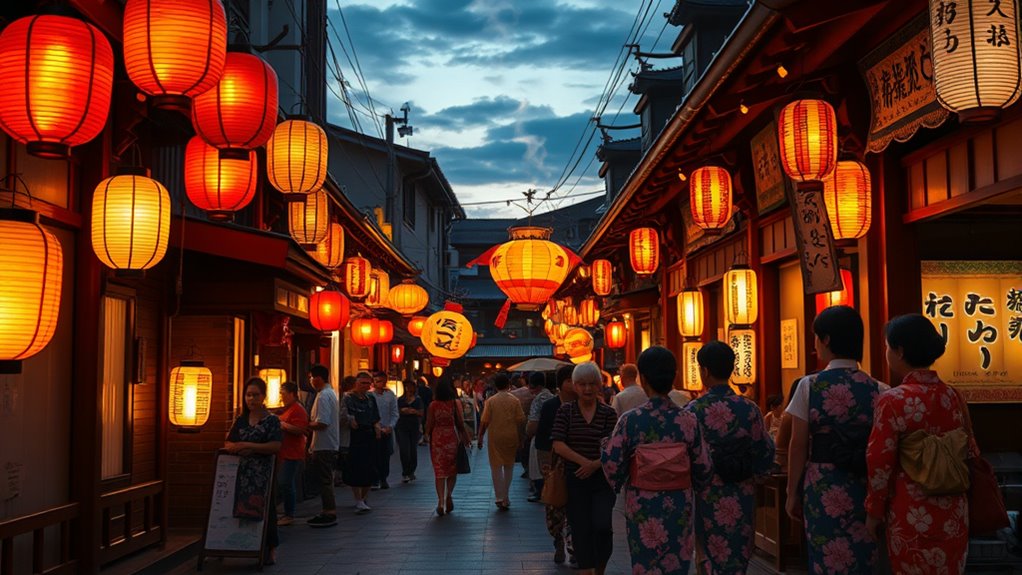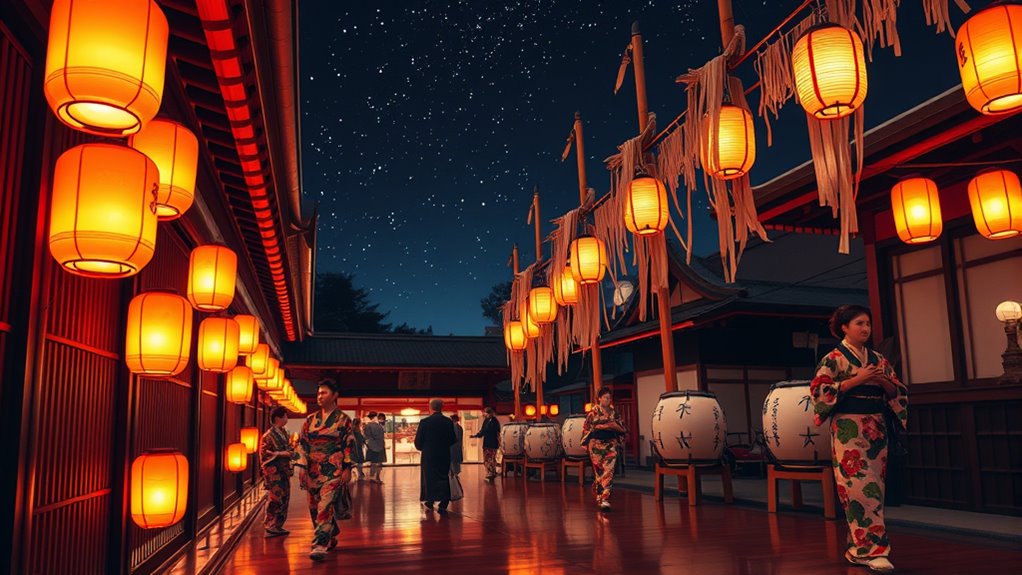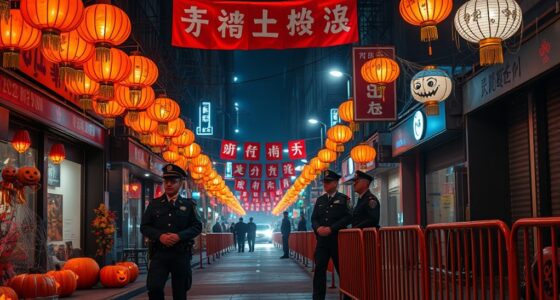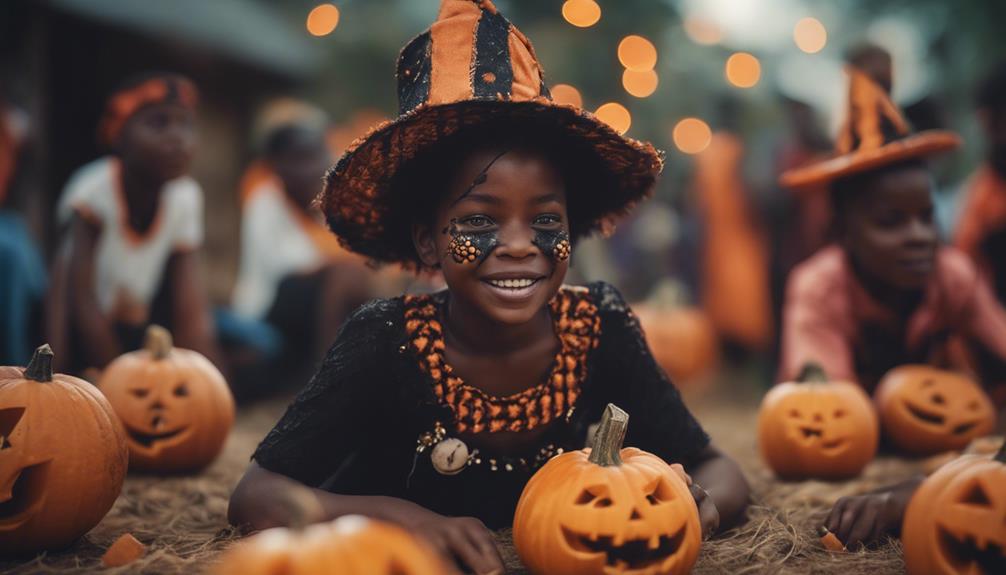Obon is a traditional Japanese festival dedicated to honoring ancestors through rituals, lantern displays, and lively dances. During the celebration, you’ll visit graves, offer flowers and incense, and participate in community Bon Odori dances that invite spirits to join. Lanterns guide the spirits back and send them peacefully at the end of the festival. If you stay tuned, you’ll discover more about the deep cultural significance and heartfelt customs that make Obon so special.
Key Takeaways
- Obon is a traditional Japanese festival honoring ancestors through rituals, offerings, and remembrance.
- Participants visit graves, clean tombstones, and offer flowers, incense, and food to pay respects.
- Lantern displays guide spirits back and send them off peacefully, symbolizing connection between the living and the dead.
- Community dances like Bon Odori celebrate life, family, and cultural unity during the festival.
- Obon emphasizes reverence, family bonds, and cultural heritage, creating a heartfelt tribute to ancestors.

The Obon Festival is one of Japan’s most important traditional celebrations, attracting millions of visitors each year. During this time, you participate in ancestral rituals that honor the spirits of loved ones who have passed away. These rituals are deeply rooted in Japanese culture, emphasizing respect and remembrance. You might visit family graves, clean the tombstones, and offer flowers, incense, and food as a gesture of gratitude and connection. This act of paying homage creates a bridge between the living and the dead, reaffirming familial bonds and cultural heritage. The atmosphere is filled with reverence and warmth, as communities come together to celebrate their ancestors’ spirits.
Obon honors ancestors through rituals, graveside offerings, and heartfelt remembrance, uniting family and culture in reverent celebration.
As the festival progresses, lantern displays become a mesmerizing highlight. You’ll see countless paper lanterns lit and floated in rivers, carried through streets, or displayed in homes and temples. These lanterns serve a dual purpose: they guide the spirits back to the world of the living at the start of Obon and send them off peacefully at the end. The soft glow of the lanterns creates a spellbinding scene, evoking a sense of serenity and spiritual connection. Many towns host lantern festivals, where participants write messages or wishes on the lanterns before releasing them. This act symbolizes sending love and good wishes to ancestors and loved ones no longer with us. The sight of these glowing displays, reflected in water or lining pathways, becomes a powerful reminder of the impermanence of life and the importance of honoring those who came before you. Additionally, the use of traditional lighting techniques enhances the visual and emotional impact of the displays.
During Obon, you might also witness traditional dances called Bon Odori, where community members dress in yukata and perform lively, rhythmic movements around a central tower or stage. These dances are more than entertainment; they serve as a joyful way to invite spirits to join the celebration. The music, vibrant costumes, and community participation foster a sense of unity and shared heritage. As you watch or join in, you realize that Obon is not just about remembrance but also about celebrating life and family. It’s a time when cultural traditions come alive, linking past and present through rituals, dance, and light displays.
In essence, Obon offers you a profound opportunity to reflect on your roots, reconnect with ancestors, and appreciate the enduring importance of family and tradition in Japanese culture. The combination of ancestral rituals and spectacular lantern displays creates a meaningful, immersive experience that stays with you long after the festival ends.
Frequently Asked Questions
How Do Families Prepare Altars for Obon?
You prepare altars by setting up a clean, dedicated space with careful altar decorations. You place ancestral offerings like food, drinks, and incense to honor your ancestors. You might add flowers, candles, and personal items to create a respectful atmosphere. As you arrange everything, you show devotion and respect, ensuring the altar is inviting for spirits. This thoughtful preparation helps connect you to your heritage during this meaningful time.
Are There Specific Foods Associated With Obon Celebrations?
Imagine a scene from a vintage movie, lanterns glowing softly in the night. During Obon, you’ll find specific foods like scented rice dumplings called chūchin dango and seasonal vegetables that honor ancestors. Obon food customs often include offerings at altars, while lantern lighting traditions create a peaceful atmosphere. These customs deepen your connection to loved ones, blending food and light to celebrate life and remember those who came before you.
What Are the Traditional Costumes Worn During Obon?
During Obon, you’ll often wear traditional costumes like yukata attire, which are lightweight cotton kimonos perfect for summer festivals. These Obon costumes are simple, comfortable, and often feature colorful patterns, helping you celebrate while honoring ancestors. Men typically wear yukata with a obi belt, and women pair theirs with geta sandals. Wearing yukata allows you to participate in dance events and festival activities with a sense of cultural pride.
How Is Obon Celebrated in Different Regions of Japan?
Did you know that over 70% of Japanese regions have unique festival variations? During Obon, regional rituals vary greatly—some areas hold elaborate dance festivals like Awa Odori, while others focus on visiting family graves. In Kyoto, lantern-floating ceremonies create a serene atmosphere, whereas in Tokyo, energetic firework displays mark the occasion. These regional rituals reflect local traditions, making each Obon celebration uniquely memorable across Japan.
What Is the Significance of Lantern Lighting During Obon?
Lantern lighting during Obon holds deep significance, symbolizing lantern symbolism that guides spirits back home. You light lanterns to honor ancestors and provide spiritual guidance, ensuring their safe return. The glowing lights create a warm, sacred atmosphere, helping families connect with loved ones who have passed. This act of illumination embodies respect and remembrance, keeping the spirits close and maintaining a strong bond between the living and the dead.
Conclusion
As you experience Obon, embrace the enchanting energy of this eternal event. Celebrate the spirits’ silent sojourn, sharing stories, songs, and soulful solidarity. Let lanterns light your longing, guiding ancestors back with gentle glows. Feel the fervor of family, faith, and flames, forging a future rooted in remembrance. Remember, Obon isn’t just a festival; it’s a fleeting, festive farewell filled with faith, family, and flickering lights—an everlasting echo of Japan’s heartfelt heritage.









